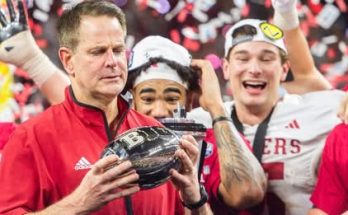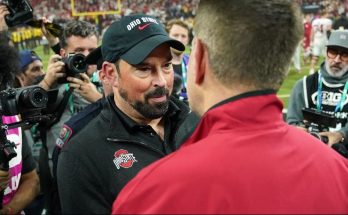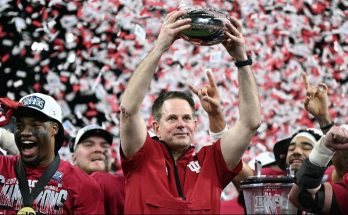Ravens Could Let Starting CB Walk in Free Agency: What Does This Mean for the Team’s Defense?
The Baltimore Ravens have long prided themselves on having one of the most formidable defenses in the NFL. With a culture rooted in strong defensive play, the team has relied heavily on its defensive backs, including their starting cornerbacks, to maintain its reputation as a dominant force. However, as the Ravens approach another offseason, the team could be faced with a tough decision regarding one of their top cornerbacks. Reports indicate that the Ravens may let their starting cornerback walk in free agency, a move that could have significant implications for both the team’s defense and its overall roster construction moving forward.
The situation has sparked debate among fans and analysts, as cornerback is a critical position in the modern NFL. With the increased emphasis on passing games and high-powered offenses, the ability to shut down opposing receivers is more important than ever. The Ravens, known for their aggressive defense and ability to disrupt the passing game, face a key crossroads with one of their cornerbacks. Letting a starting cornerback walk in free agency would require the team to be strategic in their decision-making, ensuring that the roster remains competitive while also addressing the need for long-term financial stability.
This article will explore the reasons behind the Ravens’ potential decision to let their starting cornerback walk, the factors influencing the team’s thinking, and the possible consequences for the defense and the broader roster.
The Cornerback Situation in Baltimore
The Ravens’ defensive success has been built on the strength of their secondary, which has been one of the league’s best in recent years. The team’s cornerbacks have been crucial in locking down opposing wide receivers, allowing the Ravens’ defensive front to generate pressure on quarterbacks. A strong cornerback group gives defensive coordinators the flexibility to dial up various blitzes and exotic coverages, knowing that the cornerbacks can hold their own in one-on-one situations.
In recent seasons, the Ravens have had some standout cornerbacks in their lineup, including Marlon Humphrey, who has emerged as one of the league’s premier cornerbacks. Humphrey, a former first-round pick, has been a cornerstone of the Ravens’ defense, earning Pro Bowl honors and solidifying his place as a top-tier corner. Alongside him, the Ravens have used a mix of veterans and younger players to round out their secondary, ensuring that the team has depth at the position.
However, with the approach of free agency, there is uncertainty regarding the future of one of their starting cornerbacks. Whether it’s a key veteran or a rising star, the Ravens could opt to let this player test the open market. The team may be weighing multiple factors, including salary cap concerns, the player’s performance, and the overall direction of the defense.
The Salary Cap Factor
One of the primary reasons the Ravens may allow a starting cornerback to walk is the salary cap. Like many NFL teams, the Ravens must navigate the constraints of the salary cap, which limits how much they can spend on player contracts each season. The salary cap is a constant balancing act, and teams must make difficult decisions about which players to re-sign, cut, or let walk in free agency based on the team’s financial situation.
The Ravens have several key players with expiring contracts, and the team’s cap space will be a significant consideration when deciding which contracts to prioritize. The team has already made significant investments in certain players, including quarterback Lamar Jackson, and could be looking to free up cap space for other needs. Cornerback is a premium position in the NFL, and the salary demands for starting-caliber cornerbacks can be high. If the Ravens feel that they cannot meet the financial demands of their starting cornerback, it could lead to the decision to let the player walk in free agency.
In addition, the Ravens may have younger cornerbacks or cheaper alternatives who could step into a starting role, offering a more cost-effective option. If the team believes they can maintain a strong secondary without breaking the bank on a starting cornerback, they might choose to let the veteran or more expensive player go.
Evaluating the Player’s Performance
Another factor influencing the Ravens’ decision is the performance of their starting cornerback. If the player in question has shown signs of regression or if the team feels they are no longer playing at a high level, the Ravens might decide that it’s time to part ways. In the NFL, players at positions like cornerback can have a shorter shelf life, and age or injury could impact a player’s effectiveness. Teams are often faced with the dilemma of whether to re-sign a player who may be in decline or to move on in search of a younger, more dynamic option.
The Ravens may also consider how well their cornerbacks have performed in comparison to the rest of the league. If the team feels that the cornerback in question has been inconsistent or hasn’t lived up to expectations, they may be more willing to let him go and look for a replacement through the draft, free agency, or via a trade.
Additionally, the Ravens have a deep defensive backfield, and the team may believe that they have other players who are ready to step into a starting role. Marlon Humphrey remains a key player in the secondary, but the Ravens have also drafted several talented cornerbacks in recent years. If the Ravens feel confident in their younger cornerbacks, such as recent draft picks, they might opt to give them more playing time and let the veteran cornerback move on.
The Impact of Letting a Cornerback Walk
If the Ravens do decide to let their starting cornerback walk, it could have several implications for their defense. First and foremost, it would create a hole in the secondary that would need to be filled. The Ravens would likely need to find a replacement for the departing cornerback, either through the draft or free agency. While the team has depth in the secondary, losing a proven starter would require them to find someone who can match the player’s level of performance.
The departure of a starting cornerback could also impact the team’s overall defensive strategy. Cornerbacks are responsible for covering the opposing team’s wide receivers, and a talented cornerback allows the defensive coordinator to be more aggressive with blitzes and other coverage schemes. Without a top-tier cornerback, the Ravens may have to adjust their defensive schemes to account for the change, potentially leading to a more conservative approach.
On the other hand, the team could take this opportunity to rebuild their secondary and focus on developing younger players. By letting a starting cornerback go, the Ravens might be signaling that they are ready to turn the page and give their younger cornerbacks a chance to prove themselves. This could be a long-term strategy to develop the next wave of talent in the defensive backfield, as the Ravens have historically been known for their ability to find and develop strong defensive players, particularly in the secondary.
Looking Ahead: Replacing the Cornerback
If the Ravens do decide to move on from their starting cornerback, they will need to find a replacement. The cornerback market in free agency is often one of the most competitive, with teams vying for top-tier talent. The Ravens could choose to sign a veteran cornerback who can step into the starting role immediately, or they could look to the draft for a younger, more cost-effective option.
The 2025 NFL Draft is shaping up to be a strong year for cornerback prospects, with several talented players entering the league. If the Ravens are looking to draft a cornerback, they may have several options depending on their draft position. In addition, the team could look to free agency, where veteran cornerbacks are available who could help fill the void left by the departing player.
Ultimately, the decision to let a starting cornerback walk will depend on a variety of factors, including the player’s performance, financial considerations, and the team’s long-term plans for the defense. The Ravens have the opportunity to reshape their secondary, but they must do so carefully to maintain their defensive identity.



